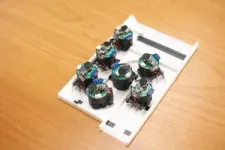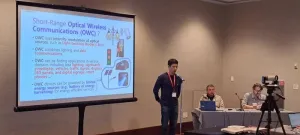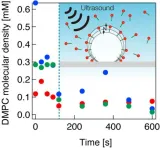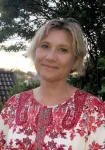(Press-News.org) In virtual meetings, it’s easy to keep people from talking over each other. Someone just hits mute. But for the most part, this ability doesn’t translate easily to recording in-person gatherings. In a bustling cafe, there are no buttons to silence the table beside you.
The ability to locate and control sound — isolating one person talking from a specific location in a crowded room, for instance — has challenged researchers, especially without visual cues from cameras.
A team led by researchers at the University of Washington has developed a shape-changing smart speaker, which uses self-deploying microphones to divide rooms into speech zones and track the positions of individual speakers. With the help of the team’s deep-learning algorithms, the system lets users mute certain areas or separate simultaneous conversations, even if two adjacent people have similar voices. Like a fleet of Roombas, each about an inch in diameter, the microphones automatically deploy from, and then return to, a charging station. This allows the system to be moved between environments and set up automatically. In a conference room meeting, for instance, such a system might be deployed instead of a central microphone, allowing better control of in-room audio.
The team published its findings Sept. 21 in Nature Communications.
“If I close my eyes and there are 10 people talking in a room, I have no idea who’s saying what and where they are in the room exactly. That’s extremely hard for the human brain to process. Until now, it’s also been difficult for technology,” said co-lead author Malek Itani, a UW doctoral student in the Paul G. Allen School of Computer Science & Engineering. “For the first time, using what we’re calling a robotic ‘acoustic swarm,’ we’re able to track the positions of multiple people talking in a room and separate their speech.”
Previous research on robot swarms has required using overhead or on-device cameras, projectors or special surfaces. The UW team’s system is the first to accurately distribute a robot swarm using only sound.
The team’s prototype consists of seven small robots that spread themselves across tables of various sizes. As they move from their charger, each robot emits a high frequency sound, like a bat navigating, using this frequency and other sensors to avoid obstacles and move around without falling off the table. The automatic deployment allows the robots to place themselves for maximum accuracy, permitting greater sound control than if a person set them. The robots disperse as far from each other as possible since greater distances make differentiating and locating people speaking easier. Today’s consumer smart speakers have multiple microphones, but clustered on the same device, they’re too close to allow for this system’s mute and active zones.
“If I have one microphone a foot away from me, and another microphone two feet away, my voice will arrive at the microphone that’s a foot away first. If someone else is closer to the microphone that’s two feet away, their voice will arrive there first,” said co-lead author Tuochao Chen, a UW doctoral student in the Allen School. “We developed neural networks that use these time-delayed signals to separate what each person is saying and track their positions in a space. So you can have four people having two conversations and isolate any of the four voices and locate each of the voices in a room.”
The team tested the robots in offices, living rooms and kitchens with groups of three to five people speaking. Across all these environments, the system could discern different voices within 1.6 feet (50 centimeters) of each other 90% of the time, without prior information about the number of speakers. The system was able to process three seconds of audio in 1.82 seconds on average — fast enough for live streaming, though a bit too long for real-time communications such as video calls.
As the technology progresses, researchers say, acoustic swarms might be deployed in smart homes to better differentiate people talking with smart speakers. That could potentially allow only people sitting on a couch, in an “active zone,” to vocally control a TV, for example.
Researchers plan to eventually make microphone robots that can move around rooms, instead of being limited to tables. The team is also investigating whether the speakers can emit sounds that allow for real-world mute and active zones, so people in different parts of a room can hear different audio. The current study is another step toward science fiction technologies, such as the “cone of silence” in “Get Smart” and “Dune,” the authors write.
Of course, any technology that evokes comparison to fictional spy tools will raise questions of privacy. Researchers acknowledge the potential for misuse, so they have included guards against this: The microphones navigate with sound, not an onboard camera like other similar systems. The robots are easily visible and their lights blink when they’re active. Instead of processing the audio in the cloud, as most smart speakers do, the acoustic swarms process all the audio locally, as a privacy constraint. And even though some people’s first thoughts may be about surveillance, the system can be used for the opposite, the team says.
“It has the potential to actually benefit privacy, beyond what current smart speakers allow,” Itani said. “I can say, ‘Don’t record anything around my desk,’ and our system will create a bubble 3 feet around me. Nothing in this bubble would be recorded. Or if two groups are speaking beside each other and one group is having a private conversation, while the other group is recording, one conversation can be in a mute zone, and it will remain private.”
Takuya Yoshioka, a principal research manager at Microsoft, is a co-author on this paper, and Shyam Gollakota, a professor in the Allen School, is a senior author. The research was funded by a Moore Inventor Fellow award.
For more information, contact acousticswarm@cs.washington.edu.
END
UW team’s shape-changing smart speaker lets users mute different areas of a room
2023-09-21
ELSE PRESS RELEASES FROM THIS DATE:
Could cerebrospinal fluid leaks be a link between traumatic brain injury and dementia?
2023-09-21
TORONTO, ON – Cerebrospinal fluid (CSF) leaks may be one of the mechanisms that link traumatic brain injury (TBI) with dementia, according to a recently published hypothesis in Alzheimer's & Dementia: Translational Research & Clinical Interventions, a journal of the Alzheimer’s Association.
Traumatic brain injuries are strongly associated with an increased risk of dementia. Unfortunately, the exact pathways underlying this relationship are unclear. This gap in knowledge makes it difficult to create preventative strategies to support patients with TBI.
CSF leaks are associated with decreased brain buoyancy and the appearance of brain sagging on MRI. Severe ...
Cough sound analyzed to identify the severity of COVID-19 patients
2023-09-21
While most individuals impacted by COVID-19 experience milder symptoms and recover within a few weeks, the global pandemic caused by the SARS-CoV-2 virus continues to pose a significant health challenge. Some of those affected may progress to develop more severe illness and pneumonia, often resulting in a more unfavorable prognosis.
Although protocols have been developed to assess patients' risk, diagnostic and prognostic tools primarily rely on expensive and less accessible imaging methods, ...
New study finds that sewage release is worse for rivers than agriculture
2023-09-21
Sewage pollution, whether treated or untreated, was found to be the primary driver of increased nutrients, algae, and sewage fungus in rivers.
Sewage discharge also radically altered plant, animal, and microbe communities, increasing the abundance of harmful species.
Run-off from agriculture was also found to lower water quality and be particularly harmful for sensitive insect groups.
Ahead of World Rivers Day (24 September), new research by the University of Oxford reveals that sewage discharge into rivers has a greater impact on water quality, and the animals ...
ETRI sets global standard for NFC-based internet communication
2023-09-21
South Korean researchers have achieved a landmark feat by setting international standards for short-range wireless communication technology, commonly used within a 10 cm range, to enable internet communication.
ETRI(Electronics and Telecommunications Research Institute) announced on the 21st July that the international standard “IETF RFC 9428(Transmission of IPv6 Packets over Near Field Communication)” was formally adopted by the Internet Engineering Task Force(IETF), a semi-private international standardization organization under the Internet Architecture Board(IAB).
Near ...
Unveiling the science of ultrasound-driven microbubble desorption
2023-09-21
Injecting drugs into the bloodstream can often harm healthy tissues as well. Drug delivery systems (DDSs) are an innovative solution designed to target specific cells and minimize such side effects. One strategy for drug delivery that has steadily gained traction involves a combination of microbubbles and ultrasound. Microbubbles are small gas-filled bubbles that can be loaded with drugs or other therapeutic agents on their surface. When exposed to ultrasound waves, these microbubbles begin to oscillate, with the ensuing ...
Sylvester researcher earns prestigious Columbia University award
2023-09-21
MIAMI, FLORIDA (Sept. 20, 2023) – A researcher with Sylvester Comprehensive Cancer Center at the University of Miami Miller School of Medicine has been selected to receive a prestigious honor from Columbia University.
Glen N. Barber, PhD, Sylvester’s internationally known cell biologist who chairs UM’s Department of Cell Biology, has been awarded the 2023 Louisa Gross Horwitz Prize from Columbia for outstanding contributions to basic research in biology and biochemistry.
Barber is the first UM faculty member to receive this award, and more than 50% of previous honorees have gone on to win the Nobel Prize. The award, which carries a $10,000 ...
Uromodulin levels may indicate risk for kidney failure
2023-09-21
Prior studies of uromodulin, the most abundant protein in urine, and kidney disease have focused primarily on urinary uromodulin levels. The current study evaluated associations of serum uromodulin levels with risk of end-stage kidney disease and mortality in a cohort of African American adults with hypertension and chronic kidney disease. The research, recently published in the American Journal of Kidney Diseases (AJKD), found that participants with lower levels of uromodulin at baseline were more likely to develop end-stage kidney disease, even after accounting for baseline kidney ...
Lurie Children’s Hospital performs innovative minimally invasive surgery for severe muscle tone in cerebral palsy
2023-09-21
Jeffrey Raskin, MS, MD, a neurosurgeon at Ann & Robert H. Lurie Children’s Hospital of Chicago, performed the first ever computer-guided radiofrequency ablation to decrease excessive muscle tone (called hypertonia) in a child with cerebral palsy.
In hypertonia, muscles are constantly activated, which causes severe pain and deformity in the bones and joints, and profoundly impacts the child’s quality of life. Medications are not always effective, and these patients do not have any other surgical options.
Dr. ...
Lower risk of haematological cancer after bariatric surgery
2023-09-21
Previous studies have shown that overweight and obesity are risk factors for several types of cancer. It is also known that obese women have a higher risk of cancer than their male counterparts, and that the risk level decreases with intentional weight loss. However, evidence of a link between obesity, weight loss and haematological cancer has been limited.
The current study, published in the journal Lancet Healthy Longevity, used data from the Swedish Obese Subjects (SOS) study at the University of Gothenburg and data from e.g., the Cancer ...
Long-lasting La Niña events more common over past century
2023-09-21
Multiyear La Niña events have become more common over the last 100 years, according to a new study led by University of Hawai‘i (UH) at Mānoa atmospheric scientist Bin Wang. Five out of six La Niña events since 1998 have lasted more than one year, including an unprecedented triple-year event. The study was published this week in Nature Climate Change.
“The clustering of multiyear La Niña events is phenomenal given that only ten such events have occurred since 1920,” said Wang, emeritus professor of atmospheric sciences in the UH Mānoa School of Ocean ...







